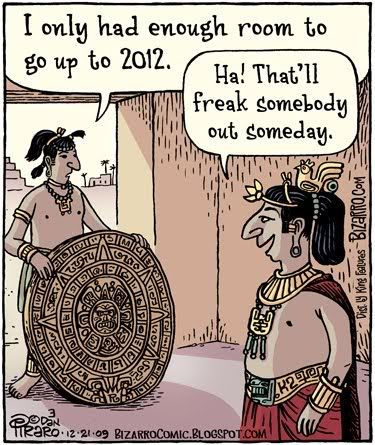
The comic I have selected is from the daily comic panel, Bizarro, written by Dan Piraro. Piraro explains that "Bizarro is about the incredibly surreal things that happen to all of us in our so-called 'normal' lives." As I love to find the humorous parts of daily life of those around me and myself, this comic is particularly appealing. I hope that by analyzing this particular sketch from December 21, 2009 that I will gain more insight, not only into this individual panel, but the rest of this artist's work as well.
This comic is especially humorous because of its relevance in our modern lives. With the arrival of the movie, 2012, in late 2009, this comic seems especially salient as this topic of the impending apocalypse two years from now is in the forefront of our minds. The story behind the comic is related to the ending of the Mayan calendar only two short years from now. Apparently this end to the Mayan calendar means the end of the world as we know it, just as Y2K was ten years ago. Hollywood has economized on this nagging worry in the minds of those around the world and now Dan Piraro is as well.
This text is seemingly simple, just two men talking to one another about the prop in one of their hands. But, it is not so simple. There is a connection and interaction between these two characters. Based on the visual representation of these characters, the relationship between these men becomes apparent. The garb of the man closest to the audience in the panel is a decorated, bejeweled, and caped– all typical signs of power or royalty. On the other hand, the man holding the calendar is dressed more conservatively with less gold jewelry and lacking much of the adornment of the other man. This says that the man with the cape is in power and has probably ordered the other man to create the calendar. As well as this visual representation of the relationship, the angles of the characters bodies portray a sense of familiarity, though they are also positioned to include the audience.
The audience is also included by the addition and position of the text within the panel. This text within the thought bubbles works together with the drawing “to have a larger affect than either has alone.” (CDA 302) The text within the panel is positioned in the upper portion so that it takes prominence over the image below. It is also framed in the cream background to direct the audience’s attention towards the thought bubbles first. The text is what creates the line, but the drawing is what adds the punch. Without the inclusion of the characters and the other props within the panel, the audience would have very little context for the conversation occurring in the thought bubbles. The same is true for the other way around–the audience can visually grasp the interaction between the characters, but cannot fully understand what is transpiring within the panel without the thought bubble conversation.
This comic is attention grabbing and well deserved. The coloration and bright, contrasting nature of the hues grabs any reader’s attention as they are flipping through the pages of the newspaper. The contrast of the single panel among many 3-paneled comics on the Funnies page also begs for the reader’s attention. This simplicity is what Piraro uses in all of his comics to not distract from his otherwise “surreal” message.
